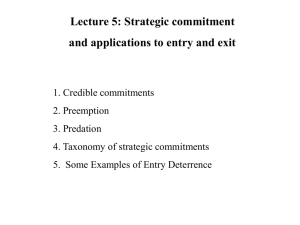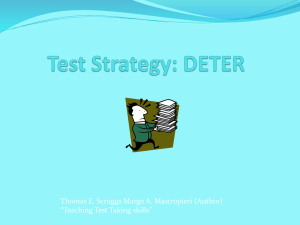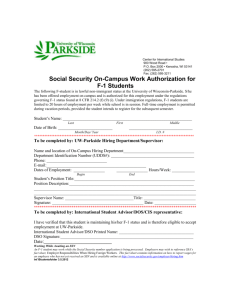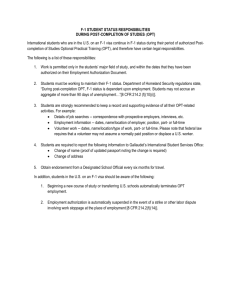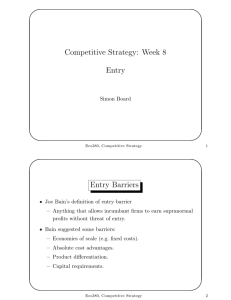Lecture 5: Strategic commitment and applications to entry and exit
advertisement
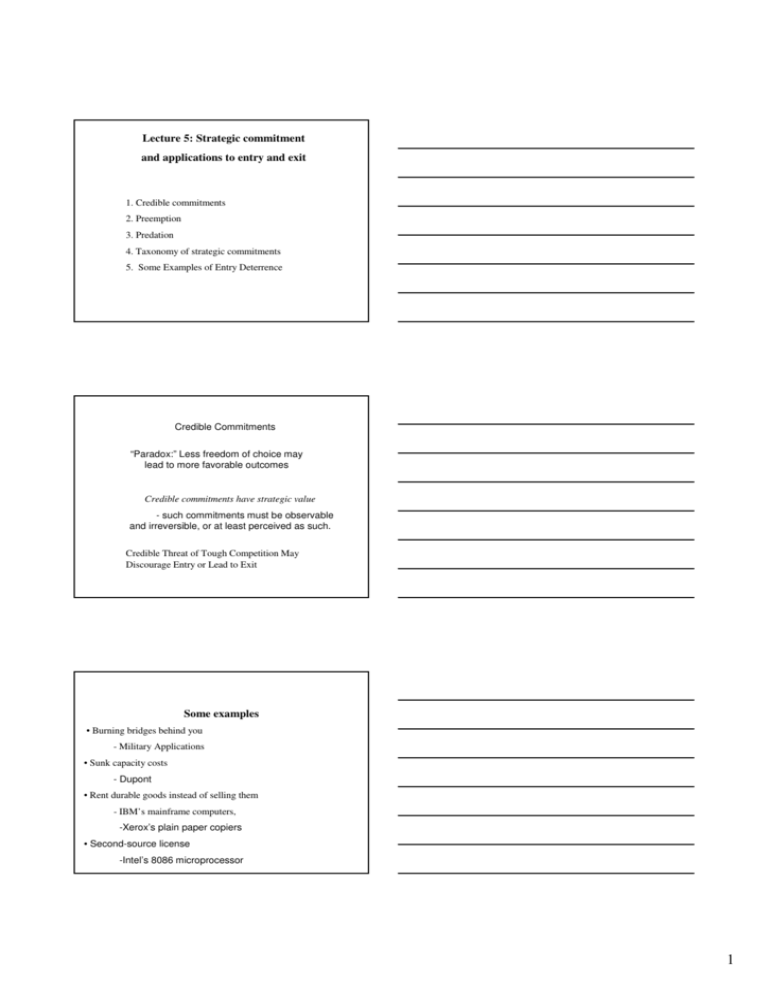
Lecture 5: Strategic commitment and applications to entry and exit 1. Credible commitments 2. Preemption 3. Predation 4. Taxonomy of strategic commitments 5. Some Examples of Entry Deterrence Credible Commitments “Paradox:” Less freedom of choice may lead to more favorable outcomes Credible commitments have strategic value - such commitments must be observable and irreversible, or at least perceived as such. Credible Threat of Tough Competition May Discourage Entry or Lead to Exit Some examples • Burning bridges behind you - Military Applications • Sunk capacity costs - Dupont • Rent durable goods instead of selling them - IBM’s mainframe computers, -Xerox’s plain paper copiers • Second-source license -Intel’s 8086 microprocessor 1 Preemption DuPont Monopoly Capacity Example: DuPont in titanium dioxide industry Excess Capacity Rival N E Enter By expanding rapidly DuPont believed that it would discourage entry or expansion by rival firms. By 1985, five of the firms competing with Dupont had exited (3 by acquisition) E N E 2 4 1 3 1 0 -1 0 Preemption (continued): control over a scarce, essential input • Alcoa (aluminum) • Patents (Xerox) • Airport takeoff and landing slots •Long-term contracts (Nutrasweet’s long term contracts with Coke and Pepsi) Predatory pricing (and limit pricing) Starting paradox: It is difficult to commit to a price. How can price then deter entry / induce exit? MCI Enter Low P Stay out AT&T HP LP HP -1 2 0 0 -1 2 5 5 Chain-store paradox – predatory pricing to deter entry will not work 2 Predatory pricing continued: Why the threat of setting low prices may be credible: •Reputation building. It may be rational to behave irrationally. (American Airlines fierce price war led to demise of Braniff. AA has a reputation for toughness. Also, Monsanto retaliated against Holland Sweetner’s (HSC’s) entry into Europe by dropping price from $70 per pound to $22-$30 per pound. HSC’s capacity at the time was just 5% of world market.) •Learning Curves (Boeing vs. McDonnell Douglas) •Building up an Installed Base (Microsoft browser) Avoiding Predation – An entry strategy Judo (the “soft way”) economics Entrant Braniff TWA Comfort Class Southwest’s Entry (Other carriers have learned to let Soutwest grab the vacation travelers, while they hold on to their business customers and frequent flyers.) Small Capacity Large Capacity Incumbent Prey NP P NP -1 1 -2 2 2 4 3 2 Example 1: Sunk Costs & Barriers to Entry Let π1= (1-K1-K2) K1 , π2= (1-K1-K2) K2. Simultaneous Move Game (Cournot): FOC: 1-2K1-K2=0 , 1-2K2-K1=0. Hence K1*=K2*=1/3. π1*= π2*=1/9. Sequential Move Game (Stackelberg): Firm 1 moves first. To find subgame perfect equilibrium, solve by backwards induction. Period 2: FOC: 1-2K2-K1=0 K2*=(1-K1)/2 Period 1: π1= (1-K1-K2*) K1=(1-K1- (1-K1)/2) K1 = .5K1(1-K1) FOC: 1-2K1=0 K1*=1/2, K2*=1/4. π1*= 1/8, π2*=1/16. (First mover advantage) 3 Clearly firm 1 earns more than it does under Cournot competition, and firm 2 earns less than it would under Cournot Competition. Firm 1 is not on its reaction curve ex-post. The best response to K2=1/4 is K1=3/8 < 1/2. Firm 1 would reduce K1 after the choice of firm 2 if it could. However, then firm 2 would choose K2>1/4 in anticipation of this response. Hence, firm 1 loses by being flexible. The fact that the investment cost is sunk allows firm 1 to commit to a higher investment level. In the previous example, there is no entry deterrence. (Firm 1 can only deter entry by choosing K1=1. But in such a case, firm 1’s profits are equal to zero.) Example 2: A Model of Entry Deterrence. Let π2= (1-K1-K2) K2-F 0 if K2>0. otherwise. If firm 1 chooses K1=1/2 (as in the Stackelberg setting), firm 2 chooses K2=1/4 as long as it earns positive profits. Otherwise, it will not enter. In such a case, firm 2’s profits are π2*=1/16-F. Hence if F>1/16, entry is blockaded. Even when firm 1 does not try to strategically deter entry, firm 2 will not enter the market. Hence, we’ll restrict ourselves to the setting when F<1/16. Firm 1 can accommodate entry by choosing the Stackelberg capacity level and in doing so earns profits equal to 1/8 as before. But firm 1 has another choice. It can choose to strategically deter entry. Firm 2’s profits are given by (1-K1d-K2) K2-F. We know that firm 2’s optimal capacity choice (if it enters) is K2*=(1-K1d)/2. Hence firm 2’s maximum profits are: (1-K1d-K2*) K2*-F=(1- K1d- [1-K1d]/2)(1-K1d)/2-F= (1-K1d)2/4-F. Hence by choosing K1d=1-2F.5,firm 1 can deter entry. In such a case, π1d= (1-K1d) K1d =2F.5(1- 2F.5). Recall that accommodation profits are π1a= 1/8. These profits are equal at F=.00536. If F > 1/16 Entry is blockaded .00536 < F < 1/16 Entry is deterred F<.00536 Entry is accommodated. 4 Taxonomy of business strategies - Informal • More aggressive behavior by Firm 1 implies less aggressive behavior by Firm 2. Be tough, that is, commit to being more aggressive. Top dog strategy •Examples: Preempt Entry, Exclude Competitors Dupont) • More aggressive behavior by Firm 1 implies more aggressive behavior by Firm 2. Be soft, that is, commit not to being aggressive. Judo economics •Examples: TWA comfort class, Southwest Taxonomy of business strategies - formal • Detergence of Entry (Two period model): • π2=[K1, x1*(K1), x2*(K1)]=0 • What strategy can firm 1 use to make firm 2’s entry unprofitable? • dπ2/dK1= ∂π2/∂ K1+(∂π2/∂ x2)(∂ x2*/∂ K1)+ (∂π2/∂ x1)(∂ x1*/ ∂ K1) = direct effect + zero – envelope thm + strategic effect • Strategic effect here: K1 changes firm 1’s ex post action:∂ x1*/ ∂ K1 • Often the direct effect is zero • In such cases, dπ2/dK1= (∂π2/∂ x1)(∂ x1*/ ∂ K1) • Investment makes firm 1 tough if dπ2/dK1<0. • Investment makes firm 1 soft if dπ2/dK1>0. • If investment makes firm 1 tough, it should over-invest to deter entry. Taxonomy of business strategies - continued • Detergence of Entry (Example): • • • • • • • • • First period: Firm 1 chooses investment K1, which lowers its MC Second period: Firms compete in quantities (x1,x2) Increase in K1, shifts firm 1’s reaction function to right Firm 1 has incentive to produce more, which lowers marginal value of output for firm 2 Formally, ∂ x1*/ ∂ K1>0. ∂π2/∂ x1<0 in Cournot setting Hence dπ2/dK1= (∂π2/∂ x1)(∂ x1*/ ∂ K1)<0 Investment makes firm 1 tough (raises x1, which hurts firm 2) Hence, firm 1 over-invests to deter entry 5 Taxonomy of business strategies - continued • Entry Accommodated (Two period model): • Here incentive to invest dictated by firm 1’s profit function • π1=[K1, x1*(K1), x2*(K1)]=0 • dπ1/dK1= ∂π1/∂ K1+ (∂π1/∂ x2)(∂ x2*/ ∂ K1) = direct effect + strategic effect • Direct effect is cost of investment • Strategic effect here: K1 changes firm 2’s ex post action:∂ x2*/ ∂ K1 • In the case of entry accommodation, – firm 1 should overinvest if the sign of the strategic effect is positive – firm 2 should underinvest if the sign of the strategic effect is negative • Same example as before: • (∂π1/∂ x2)<0, (∂ x2*/ ∂ K1)<0, • hence strategic effect (∂π1/∂ x2)(∂ x2*/ ∂ K1)>0, implies overinvest 6
